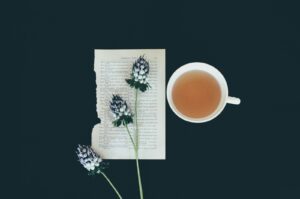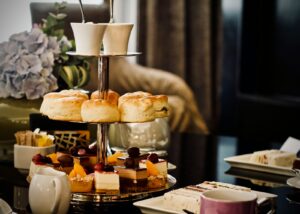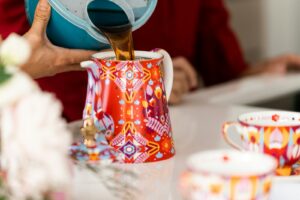Imagine settling into a cozy afternoon with a steaming cup of tea, ready to unwind or chat with friends. Yet, even in such a simple pleasure, there’s a rich tapestry of customs to consider. The etiquette of tea drinking is deeply rooted in traditions that span from the bustling tea rooms of the UK to the serene tea ceremonies of Japan and China. Understanding these practices isn’t just about following rules; it’s about embracing a cultural experience that enhances your enjoyment and respect for this timeless beverage.
Navigating the etiquette of tea drinking can seem daunting at first. Whether you’re stirring your tea correctly or placing your spoon just so on the saucer, each detail offers a glimpse into the history and cultural importance of tea. Let’s delve into these rituals and discover how you can enjoy your tea not just as a drink, but as an act of cultural immersion and elegance.
The History of Tea Etiquette
Origins and Cultural Variations
Tea drinking, a revered tradition with roots stretching back millennia, showcases distinct cultural variations that reflect the intricacies of social customs and historical contexts. In China, often considered the birthplace of tea, the practice of tea drinking spans more than 4,000 years, evolving from a medicinal concoaliton to an entrenched social ritual. Chinese tea ceremonies, known for their solemnity and philosophical depth, emphasize harmony, respect, purity, and tranquility—an ethos encapsulated in the Cha Dao, or the Way of Tea.
Transitioning from East to West, tea etiquette took on new forms. The introduction of tea to Europe in the 17th century by Portuguese and Dutch traders transformed it into a symbol of status and social sophistication, particularly in Britain. Here, afternoon tea evolved into a significant social event during the early 19th century among the upper class, inaugurating customs such as the “tea party,” where the practices of serving a selection of teas accompanied by sandwiches and scones became entrenched in the social fabric.
Beyond simple beverage consumption, Japanese tea etiquette presents another unique tradition, the tea ceremony or Chanoyli, which blends spirituality with hospitality, focusing on the aesthetics of tea preparation and serving. This ritual is deeply tied to Zen Buddhism and emphasizes the beauty in simplicity—a concept that influences not only tea-making but also the architecture of tea rooms and the design of tea utensils.
Each of these traditions offers a window into how cultures across the world imbibe tea not just as a drink but as an experience, laden with historical significance and social ethics. As you explore these varied traditions, you gain not only appreciation for the beverage itself but also a deeper understanding of the global cultures that cherish it.
Essential Rules of Tea Etiquette
The Right Way to Hold a Teacup
To master tea etiquette, start by knowing the correct way to handle your teacup. Place your index and middle fingers behind the handle, and rest your thumb on the front. Ensure that your fingers don’t curl through the handle itself. Support the base of your teacup with your ring and pinky fingers, which must remain angled downwards, not raised. This grip helps maintain balance and control of the teacup, enhancing the sipping experience while adhering to proper tea drinking etiquette.
Proper Stirring Techniques
When it’s time to stir your tea, there’s a specific method to follow. First, if you’ve added sugar or milk, use your teaspoon to gently stir from the 6 o’clock to the 12 o’clock position, typically making just two to three rounds within the teacup. Avoid stirring vigorously or creating a swirling motion, as this is considered rude and may even cause unwanted noise or damage to the teacup. Once done, carefully place your spoon on the saucer behind the cup. This technique not only prevents clinking noises but also respects the serene ambience of a tea session.
The Dos and Don’ts of Sipping Tea
When sipping tea, take modest, quiet sips to truly embrace the essence of afternoon tea etiquette. Do not slurp your tea loudly, as this disrupts the tranquility of your surroundings. Make sure your spoon is off the teacupid you’ve finished stirring, keeping the tea area uncluttered. If you need to leave your seat, remember to gently place your teacup back on the saucer without lifting the saucer itself, unless you’re standing, in which case, hold the saucer in your left hand while sipping with your right. This attention to detail ensures that your tea drinking practice enhances your social grace and etiquette at any tea gathering.
Afternoon Tea vs High Tea
Understanding the Differences
When discussing the etiquette of tea drinking, it’s crucial to differentiate between afternoon tea and high tea, as each carries its unique set of traditions and social implications. Afternoon tea, traditionally enjoyed between 3 and 5 PM, represents a time for leisure and sophistication. Often associated with the upper class, this ritual involves a spread of finger sandwiches, scones with clotted cream and jam, and an assortment of sweets served on a three-tiered stand. It’s an event marked by its genteel social graces and formal dress code, often considered an opportunity to showcase good manners in a social setting.
High tea, contrary to its name, originated from the working-class meal served at the end of the workday, around 5 or 6 PM. It includes heartier dishes like meat pies, eggs, and fish, served along with bread, butter, and tea. High tea is more akin to a full dinner than the light snacks of afternoon tea, reflecting its roots in the bustling lives of the 19th-century British working class. The term “high” comes from the high-backed chairs and higher dinner table used, as opposed to the relaxing lounges of afternoon tea.
Knowing these distinctions helps you appreciate the cultural depth behind each tea experience and ensures you approach them with the correct decorum. Whether you’re enjoying the refined tranquility of afternoon tea or embracing the more robust high tea, understanding their origins and the appropriate etiquette enhances your tea-drinking pleasure.
Setting the Tea Table
Layout and Decorum
When setting the table for afternoon tea, a blend of aesthetics and functionality remains crucial. Arrange the tea table with a centerpiece such as a floral arrangement to enhance the ambiance, keeping it low enough to encourage easy conversation across the table. The proper tea etiquette requires the china teapot, sugar bowls, milk jugs, and teacups to be placed at the center of the table for accessibility. The table should be draped in a clean, elegant tablecloth, with linen napkins provided for each guest. Plates should be set in front of each chair, with teaspoons and forks placed to the right of the plates, and knives to the left if snacks requiring them are served.
What to Serve and How to Serve It
Traditionally, afternoon tea includes a menu of finely cut finger sandwiches, freshly baked scones served with clotted cream and jam, as well as a variety of delicate pastries and cakes. Begin by serving savories like sandwiches, progressing to scones, and conclude with sweets, to honor the typical order of afternoon tea. Serve each course from separate tiered serving stands—savories on the bottom tier, scones in the middle, and sweets on the top, to maintain organized and elegant access to the array of options. As a host, ensure each guest receives their tea brewed according to preference with all accompaniments like lemon slices, milk, and sugar served in separate dishes to maintain the highest standards of tea etiquette.
Attire and Mannerisms
Dress Code for Tea Events
When attending a tea event, dressing appropriately reflects respect for the occasion and its participants. A smart casual dress code typically suffices for most tea events. For women, this may include a modest dress or a blouse with a skirt or trousers. Men often opt for slacks paired with a collared shirt; ties are optional unless specified. In settings that require more formality, such as a high tea linked with a special occasion, dresses and suits might be more appropriate. Footwear should be clean and conservative, complementing your outfit while ensuring comfort as tea events can extend over several hours.
Polite Conversation and Behavior
At tea events, good manners dictate the flow of conversation and behavior. Begin with quiet sips of your tea, taking care not to slur single words or make loud noises, as these are considered rude. Polite conversation should revolve around light topics, avoiding controversial subjects to maintain a pleasant atmosphere. It’s important to engage with all guests, making eye contact and including everyone in the discussion to ensure no one feels left out. Remember to use your napkin discreetly, place it on your lap, and avoid placing used utensils back on the table. Observing these polite behaviors helps you enjoy the full experience of the tea event while respecting the etiquette embedded in this cultural tradition.
Global Tea Traditions
Chinese Tea Ceremony Practices
In China, the tea ceremony, often known as ‘Gongfu Tea Ceremony,’ is a spiritual and communal event that emphasizes the art of tea preparation and sipping. You’ll notice the meticulous care taken in the selection of tea leaves, the temperature of the water, and the timing of infusion, each step aimed at enhancing the flavor and aroma of the tea. It’s not just about drinking tea; it’s about appreciating the tranquility and mindfulness that comes with it. Moreover, the host performs these protocols with a high level of skill, showcasing both their knowledge of tea traditions and their respect for the guests.
The ceramics employed are equally crucial. Often, a small, unglazed teapot made of Yixing clay is used, which is believed to retain the memory of the tea, adding depth to each subsequent brew. Each guest, using small sips, enjoys their tea from tiny cups, which are thought to concentrate the tea’s essence. This ceremony is not only a significant cultural experience but also a moment to forge deeper connections through the shared appreciation of fine tea.
Japanese Tea Ceremony Rituals
The Japanese tea ceremony, known as ‘Chado’ or ‘The Way of Tea’, is another profound representation of tea drinking etiquette and philosophy. Unlike other tea ceremonies, Chado revolves around four principles: harmony, respect, purity, and tranquility. The setting is meticulously prepared to reflect these values, often held in a designated tea room, where every element is symbolic, from the utensils used to the decoration of the space.
During the ceremony, the tea master, or Teishu, prepares ‘Matcha’ (powdered green tea) for the guests. The process involves precise movements and a sequence that guests follow, emphasizing respect and attention to detail. The Matcha is whisked with a bamboo brush in a bowl until frothy and served as part of a minimalist ritual that includes sweets to complement the bitter taste of the tea. This ceremony offers a moment of calm and reflection, allowing you to appreciate the subtleties of the tea and the serene environment created for the occasion.
Final Thoughts: The Etiquette of Tea Drinking
Embracing the proper etiquette of tea drinking enriches your understanding of global cultures and enhances your social interactions. Whether you’re participating in a serene Japanese Chado or enjoying an elegant British afternoon tea the rituals and traditions you observe serve as a bridge to deeper cultural insights. Remember it’s not just about drinking tea—it’s about celebrating the art of tea drinking and the mindfulness it cultivates. So next time you lift your teacup do so with awareness and respect for the rich traditions that have shaped this age-old practice.
Other suggested articles:
Wine Tasting Etiquette: Guidelines for the Discerning Connoisseur
Wedding Etiquette: 4 Guidelines for Graceful Celebrations
Modern Dating Etiquette: 12 Guidelines for Romance
International Etiquette: Cultural Tips for Global Communication



